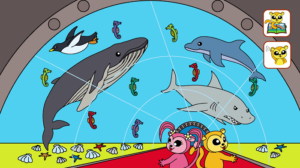 At Modern English, where I teach Happy Valley 1 and Happy Valley 2, we spend the week before Obon doing a summer craft. This year the Happy Valley 2 kids (4-5 yo) made beaded bracelets and the Happy Valley 1 kids (and one Happy Valley 2 kid in for a make-up) made rainbow fish.
At Modern English, where I teach Happy Valley 1 and Happy Valley 2, we spend the week before Obon doing a summer craft. This year the Happy Valley 2 kids (4-5 yo) made beaded bracelets and the Happy Valley 1 kids (and one Happy Valley 2 kid in for a make-up) made rainbow fish.
While making the bracelets, my 5 yo student made a nice little English/Japanese ダジャレ joke. Each student could have 10 beads. When H-chan reached 10 beads she counted to check, “1, 2, 3…9,終点です。」I and the 4 other students all looked up immediately and everyone started to laugh. We knotted hers off as the kids thought of other silly things like, adding “please” to the end of everything. “Thank you, please.” “Finished, please.” “No, please.” This is why I support doing craft work and other activities even in once a week classes. Kids get to use what they know and always, without a doubt, someone says something funny or different. PLAYING is learning!
In the Happy Valley 1 class (2-3 yo), we read The Rainbow Fish and then made our own rainbow fish. I discovered who the artist is! In this case it is little K-kun. His color pattern choice was very carefully thought out and his fish looked distinct. He is still just using gestures to communicate with me, but I know when he does talk it will be as great as his fish! Another reason why crafts and other activities across disciplines are important. We all have different strengths and in this case, the quiet artists got a moment to shine.
I was asked how I do crafts with kids. Honestly, it depends. Here are the questions I ask myself before preparing.
1) How much time do you have?
2) How many kids?
3) How old are the kids? Can they use craft supplies (scissors, glue, pencils, etc)?
4) Will they be with or without their parents?
5) What kind of language do they have already?
6) What language might you want them to use for the particular activity?
7) What concepts do they understand?
All of these will play a part in how you do a craft or other cross-curricular activity and while I would love to say it is one size fits all, just do 1-2-3, it isn’t.
In the case of the 2-3 yo student, their mother’s came with them. The 4 yo make-up student came alone. All the students can say their colors (minus one who has yet to say anything, but communicates well with gestures we’ve learned in class), “Please.” “Thank you.” “Here you are.” “Yes.” “No.” “OK.” They can also ask, “May I have a…” or “…, please.”
Knowing that, I wanted to add language for choice. For example, giving them the choice between 2 kinds of red paper and letting them choose using the language, “This one, please.” Or I would ask if they wanted a long or short piece of seaweed (which I precut) or a big or small shell (which I pre-drew for them to cut). In which case they could just say, “Long.” or “Short.” All language was in context, so I didn’t need to pre-teach anything. We just went for it.
I prepared the seaweed and outlined the shells and starfish. Kids could choose what color fish they wanted and on the spot I drew a simple fish for them to cut out with their moms. Had there been more students, I would have precut some different color options. I also prepared some strips of shiny origami and matte construction paper, which I cut into a squiggly shape at the top. Had the students been older and more capable with scissors, I would have left the squiggly cuts to them. Then, when students said to my rainbow fish, “Please share. May I have red (paper), please?” they could get the color they wanted and then just cut the size piece we estimated that they would need.
If two students wanted the same color, I would hand one piece to one student who would then share it with the other student.
People often say that children have a short attention span. In certain cases this is very true. However, it is my experience that when students are tasked with making something, they will stay focussed for way longer than the 3-5 minutes people say they can. They made their fish in about 40 minutes, leaving 10 minutes for the book and our greetings. Honestly, I think it is important not to rsh through these activities. It’s not only stressful, but in taking the time, you may discover other language you could input or get them to use.
With enough time, you could add in a show and tell at the end. Depending on the kids you could have them simply say, “My fish is red, blue and yellow.” or add a little self-intro, “Hello. My name is Catherine. My fish is red, blue and yellow. Thank you.”
Here is a picture of their lovely fish!
